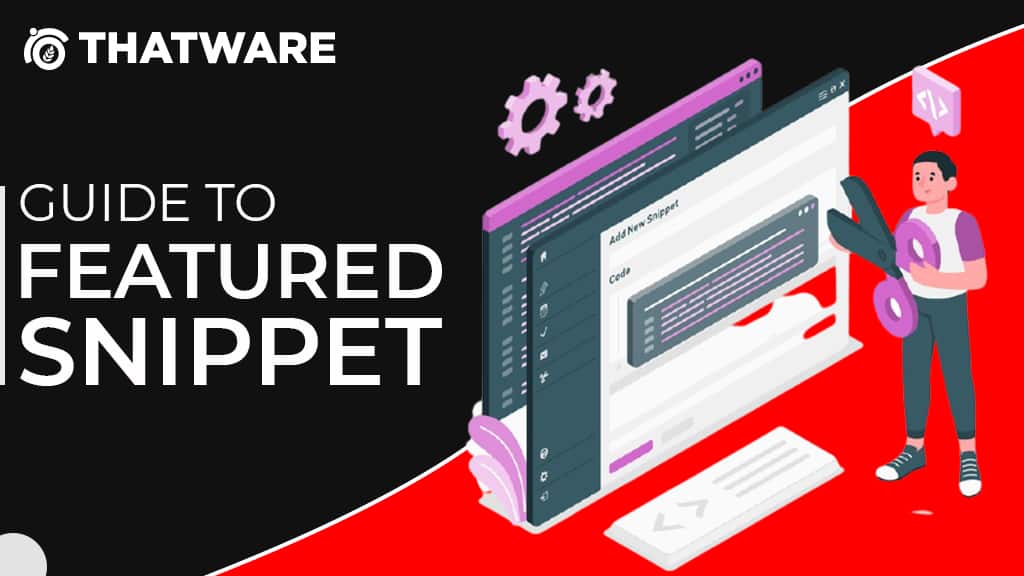SUPERCHARGE YOUR Online VISIBILITY! CONTACT US AND LET’S ACHIEVE EXCELLENCE TOGETHER!
The featured snippet directly responds to your question that is displayed in a structured small box above the organic search results. Google displays three sorts of snippets from the top-ranked websites based on the term.
After the knowledge graph, it’s another method Google aims to improve the user’s search experience and keep people on Google to answer their inquiries.

What Exactly Is A Featured Snippet?
The highlighted snippet includes a summary of the answer a user has looked for, a link to the page, as well as the page title and URL. The amazing thing about highlighted snippets is that you don’t have to be at the top of Google to appear in the snippet box (although it certainly helps). Other first-page results may appear in the snippet section by optimizing the content for snippets.
What Are Featured Snippets And How Do They Work?
The Google search engine identifies a user’s query and finds the sites that best answer the query. Unfortunately, there is no magic button or technique to ensure that your web pages display in the snippet section, but it would be lovely if there were. Ranking for featured snippets, like SEO, is a process of optimizing your web page (or making it as easy as possible) for Google to understand that the material on this page will be the most useful for this inquiry and also contains a summary that Google can elegantly put into that feature box.
What Are The Various Types of Featured Snippets?
- Table: Google may show a highlighted snippet as a vertical table to deliver the best-formatted response. The table typically has three columns and five rows, including a header. Any colour coding, design, or image alteration is permissible as long as it’s in plain HTML.
- List: If the user query calls for a list answer, Google is more likely to display a bulleted list result in the highlighted snippet. The excerpt will show as a bulleted list if the source website answers the query in a bulleted list or with numbered headers. Google typically displays 5-8 list items, omitting the header.
- Paragraph: Google will provide a paragraph snippet for a straight inquiry or query answered in a phrase. The paragraph is around 40-55 words long. A paragraph snippet is usually used to answer questions that begin with “why,” “when,” “what,” “was,” or “which.” Wikipedia owns the majority of paragraph snippets. So, look at their content formatting!
Steps To Get A Featured Snippet
Step 1: Look For Possibilities.
Begin by reviewing your ranking content.
Google gives the highlighted snippet to websites that rank better in the SERP (search engine result page). Find out which pages of yours are in the top 10, or maybe in the top 10 if you improve them, using your preferred SEO tool.
Begin by conducting keyword research.
If you don’t have any material ranked in the top ten and wish to create some, that’s fantastic! Begin by conducting keyword research to identify your readers’ queries. Look through internet forums or personal experiences to identify some fundamental questions consumers seek. Answer the public is an excellent resource for locating similar inquiries. When you’ve identified the keywords and queries, create captivating content that provides the best response and sufficient information to the searcher. After that, using the techniques below, arrange your material in a way that will assist you in achieving the highlighted snippet while adhering to your typical best SEO practices.
Step 2: Examine The Inquiry Structure And The Purpose Of The Searcher.
Before you begin writing the response, study as much as you can about the issue so that you may provide the greatest possible answer; remember that a featured snippet is more than simply a direct answer; it is about appropriately addressing the searcher’s inquiry in a well-formatted manner. It’s much easier if there’s already a snippet for the term. Examine the featured snippet attentively to see why Google has decided to offer them the coveted number (0) position on the first page.
Take a look at their SEO tactics, backlinks, and other data as well. Examine their keyword utilization in their text, alt-tags, internal linking, and every other little technical component and strategy.
Step 3: Provide A Straightforward Response That Is Format-Appropriate.
Include your straightforward response in a paragraph beneath the header tag—and be direct. Keep your response towards the top of the page to emphasize its significance. Aim for a response that is 40 to 50 words lengthy (Moz). Make sure your response is descriptive, clear, and complete and that it addresses the question logically. Keep the language simple: sentences should not be too lengthy, and passive voice should be avoided. If the solution is more complicated, consider breaking it into digestible steps in a bulleted or numbered list format.
Paragraph Snippet
- Include the exact keyword in the snippet heading section
- Keep the main answer in the first 40-55 words
- Include keywords in the heading and paragraph as well
- After that, explain the abbreviation in the same way Wikipedia does, I.e. Search Engine Optimization (SEO)
- Place the snippet paragraph higher on your post
List Snippet
- Use the primary term in your snippet header
- It is recommended to use “bullet points” for making a list
- You can also use numbers (1, 2, 3 etc.) OR
- Use the same headings for stages As an example, we utilized H4 for our stages.
Table Snippet
- Add the essential rows at the top of the table
- Feel free to add extra columns and rows if needed (you don’t have to limit yourself to 3 columns and 5 rows)
- Use a different colour for the table heading and make it bold. Make it appealing.
- Don’t forget to include a keyword in the table heading.
Step 4: Optimize The Ranking Factors.
Google considers numerous variables before awarding a highlighted snippet position. Among them are:
- That page’s organic click-through rate (CTR);
- Bounce Rate;
- Page Speed;
- Overall User Engagement
So, after you’ve created a fantastic featured snippet response, you should fill the page with very relevant and helpful information. Make it user-friendly, amusing, engaging, thorough, and high-quality. In this case, user involvement is critical. This is what Google looks for while testing your website. A page with entertaining and user-friendly content will assist boost visitors to the page and keep its SERP rank.
Please do so if you can include a graphic, a video, or go into further detail on the issue further down the page. You want to make your page as useful to readers as possible. Your content aims to help people and differentiate yourself from the competition so that consumers will eventually buy from you, link to you, share your website, or remember you. Google will reward you with the snippet position.
Why Do Featured Snippets Matter for Search Engine Optimization?
For companies and content producers hoping to rule the SERP space, featured snippets are essential. Snippets provide unmatched visibility by showing up at position “0,” which elevates your content above even the highest-ranking organic results.
Advantages of Featured Snippet Ranking:
- Enhanced CTR: Research indicates that snippets can produce click-through rates that are up to 8% greater than those of typical results.
- Increased Authority and Trust: Google shows its faith in the correctness and pertinence of your material when it highlights it in a snippet.
- Mobile and Voice Search Optimization: Snippets provide easily readable, bite-sized content, as over 60% of Google searches are performed on mobile devices. Furthermore, answers are frequently taken from featured snippets by voice assistants such as Google Home and Alexa.
Typical Obstacles in Featured Snippet Ranking
Although snippets have many benefits, obtaining and keeping them can be challenging. Here are a few challenges that companies frequently encounter:
- High Level of Competition: For high-volume keywords in particular, everyone aspires to rank for the coveted snippet box.
- Recognizing Search Intent: If you misunderstand the user’s inquiry, Google may ignore your material.
- Constant Algorithm Changes: Consistent ranking is a moving aim because Google regularly modifies the selection of snippets.
How to Use Featured Snippets to Optimize for Voice Search
Users’ interactions with search engines are changing due to voice search. To adapt your featured snippet approach to the latest developments in voice search:
- Pay Attention to Conversational Keywords: Use long-tail, query-based keywords that resemble inquiries in natural language.
- Direct and Brief Responses: Voice assistants give preference to content that offers a brief response, usually less than 40 words.
- Markup for Schemas: To make your pages voice-search-friendly, include structured data.
For example, your material should begin with the following when someone asks, “What is a featured snippet?”
“A featured snippet is a highlighted answer box displayed above search results.”
What’s the Difference Between Knowledge Panels and Featured Snippets?
Although knowledge panels and featured snippets both offer fast responses, they have different functions:
- Featured Snippets: Usually in the form of a paragraph, list, or table, they are taken from third-party websites and directly answer a user’s question.
- Knowledge Panels: Typically found on the right-hand side of the SERP, these include organized information gleaned from reliable sources such as Wikipedia or Google’s database.
Understanding the distinction enables you to adjust your content approach appropriately. Optimize your content for snippets. Develop your expertise in a certain field for knowledge panels.
How to Monitor the Performance of Featured Snippets?
To evaluate the success of your plan, you must keep an eye on your snippet performance. Here’s how:
- SEO Tools: To monitor snippet ownership and spot chances to rank for new ones, use tools like SEMrush, Ahrefs, or Moz.
- Search Console Insights: Check whether certain queries generate traffic using the “Search Appearance” tab in Search Console Insights.
- Analysis of Competitors: Determine which of your rivals are most commonly featured in snippets and assess their tactics.
- Pro Tip: To record your successes, losses, and the content format that suits you best, make a spreadsheet.
Advice for Maintaining Your Featured Snippet Placement
Maintaining a featured snippet becomes more difficult after you’ve secured one.
- Maintain material Freshness: Update your material frequently to take advantage of the newest search trends.
- Increase the Depth of Content: To increase user engagement, include more information, images, or videos.
- Keep an eye on your competitors: If your snippet becomes overtaken by another website, examine the changes they made and make the necessary adjustments.
The Future of Featured Snippets
Featured snippets will develop along with AI and machine learning.
- New Trends: Visual Snippets: Look for more image-based snippets in response to queries that are mostly visual, such as “best winter outfits.”
- AI-Generated Answers: Search engines may use AI to produce snippets of material, which makes credibility and accuracy even more important.
- Speech-First Snippets: As smart speakers become more widely used, it will be more crucial to optimize for speech snippets.
How to Respond to Inaccurate or Negative Featured Snippets
Snippets occasionally show erroneous or out-of-date content. This is how to deal with it:
- Utilize Google Feedback: Select the feedback option for the snippet and submit any errors.
- Update Your Content: Verify that the data on your page is accurate and make any required changes.
- Perform Better Than Your Rivals: Replace the inaccurate fragment with a more thorough, organized response.
How Featured Snippets Are Used in Various Industries
The methods used to rank for snippets vary per industry.
- E-commerce: For “best products” queries, use list snippets.
- Healthcare: Give thorough, paragraph-by-paragraph responses to “what is” queries.
- Travel: To show comparisons between places, flights, or lodging, use table fragments.
Typical Errors to Avoid When Aiming for Featured Snippets
When optimizing for snippets, stay away from these mistakes:
- Keyword stuffing: Using too many keywords can make your writing difficult to read.
- Ignoring Formatting: It is unlikely that poorly formatted content will be shown.
- Ignoring Search Intent: User queries won’t be satisfied by misaligned content, rendering snippets inaccessible.
AI’s Role in the Selection of Featured Snippets
Google finds and extracts the most pertinent content for snippets using sophisticated artificial intelligence, such as BERT and MUM. Gaining an understanding of these AI algorithms can help you improve your content for increased visibility.
How AI Improves Snippets:
- Understanding Context: To ensure precise query matching, AI considers context in addition to keywords.
- Recognizing User Intent: AI can determine if a user would like visual help, a thorough explanation, or a prompt response.
- Better Semantic Analysis: AI determines whether your text offers a useful snippet by evaluating its whole meaning.
- Optimization Tip: Pay close attention to crafting succinct, contextually rich responses to questions that reflect user intent. You may examine how search engines understand your material with tools like Google’s NLP API.
Core Web Vitals’ Effect on Featured Snippets
Snippet rankings heavily rely on Google’s Core Web Vitals measures, which include Cumulative Layout Shift (CLS), First Input Delay (FID), and Largest Contentful Paint (LCP).
The Significance of Core Web Vitals
- Page Speed: Snippet placements are more likely to be secured on sites that load more quickly.
- Experience of the User: Low bounce rates and high engagement tell Google that your content is worthy of being featured.
How to Perform Better:
Measure and improve loading times with tools such as PageSpeed Insights.
Avoid intrusive advertisements and appropriately define image proportions to minimize layout adjustments.
Conclusion
Ranking for a highlighted snippet necessitates a concentrated effort of investigating and evaluating the searcher’s intent and the snippet structure. Continue to test, review, and repeat—improve your markup, speed up your site, record your modifications, wait for any snippet changes (18-36 hours), refresh, and repeat.
The road to ranking for a highlighted snippet does not end with technique selection and content optimization. Above all, you must continue to test, review, and repeat the process for as long as it takes to obtain what you want (and not give up!). Always be on the lookout for search engine result page (SERPs) changes. If you see any significant changes in the SERP, check and update your content as well. As previously said, attempt to make your sample stand out while adhering to the major style rules.
By following these insights, the website owner can retain more users, increase engagement, and ultimately grow their business.

Thatware | Founder & CEO
Tuhin is recognized across the globe for his vision to revolutionize digital transformation industry with the help of cutting-edge technology. He won bronze for India at the Stevie Awards USA as well as winning the India Business Awards, India Technology Award, Top 100 influential tech leaders from Analytics Insights, Clutch Global Front runner in digital marketing, founder of the fastest growing company in Asia by The CEO Magazine and is a TEDx speaker and BrightonSEO speaker..


